He transformed political conformism into his life motto. He even entered into marriage only to buy into the favors of the leader. Nevertheless, he was just killed on the orders of Duce.
As the midnight passes, Galeazzo Ciano - former foreign minister of fascist Italy, and still the son-in-law of the Italian fascist leader Benito Mussolini - in a prison cell in Verona pulls out a vial with potassium cyanide from hiding. He chews the glass of the vial, swallows the poison. After half an hour, disappointed Ciano appears on the prison corridor - the cyanide did not work.
The would-be suicide fighter does not realize that Hildegard Burkhardt Beetz, a young, beautiful German woman, wife of a Luftwaffe airman on the Eastern Front, replaced the poison given to her by an Italian doctor and handed him a harmless solution of potassium chlorate. Beetz, an agent of the SS Security Service, was recently sent by her superiors to surveillance Ciano.
The SS generals did not foresee only one thing - that the handsome womanizer Ciano would seduce Beetz, who would start fighting for his life, as well as for the life of Ciano's wife - Eddy. But Beetz's feelings also have an unexpected effect. The agent changed the vials to extend the life of her beloved for at least a few hours. In the morning, Ciano will be shot.
The Golden Youth
The path of Galeazzo Ciano, Count di Cortellazzo, son of the famous Italian naval commander of the World War I, Admiral Constanzo Ciano, to death row began in the early 1920s. As a teenager, he joined the fledgling fascist movement, in which he immediately took a privileged position - one one of the founders of the Italian Fascist party was his father.

Beautiful Hildegard Burkhardt Beetz. A German agent who has a crush on Ciano.
At the age of 19, Galeazzo took part in the famous march on Mussolini's Rome, and as a 22-year-old, after a short adventure as a journalist of the fascist press, he was nominated as a consul fascist Italy in Rio de Janeiro. Then there were diplomatic missions in Beijing and Shanghai.
The marriage of Countess Ciano with Edda Mussolini, daughter of duce. Mussolini's son-in-law became Minister of Foreign Affairs at the age of 33.
Playing toy soldiers
Intelligent, cynical, power-hungry, Ciano at first opted for his father-in-law's alliance with Hitler and the imperial expansion of Italy - in the Italian invasion of Ethiopia in 1935–36, Galeazzo personally took part as the commander of a bomber squadron (this expedition was largely a propaganda campaign ) . Ciano readily supported the seizure of Albania and the attack on Greece, but after the Third Reich conquered France, he began to secretly distance himself from Hitler's policies.
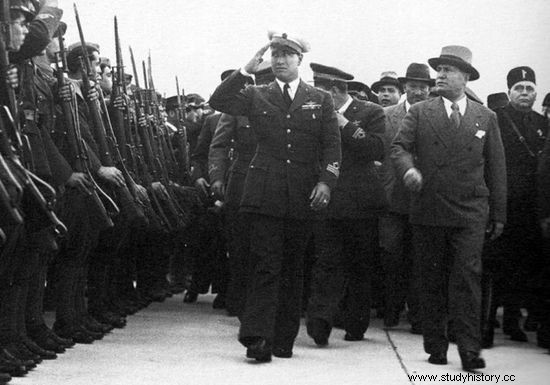
Galeazzo Ciano in a pilot's uniform (salutes) together with Benito Mussolini inspect soldiers going to war with Abyssinia. May 1936.
And from his father-in-law, faithful to the Führer. In 1942, Ciano attempted secret peace negotiations with the Allies, incl. with the help of the Polish Sapieha princes. The following July, at a meeting of the Great Fascist Council, Ciano backed Dino Grandi's motion to remove Mussolini from power.
However, the imprisoned Mussolini was released by German paratroopers, and Ciano, who did not realize how hated he was in Italy, and threatened with arrest by the new Italian government of Marshal Badoglio, fled with his family to the Third Reich. Hitler, however, agreed to hand over Ciano to the Italian fascists who were still ruling by the grace of Germany in northern Italy.
The day before, after a show trial, Ciano and four others were the fascist hierarchs De Bono, Marinelli, Gottardi and Pareschi, who had been accused of treason by their former comrades, had been sentenced to death.
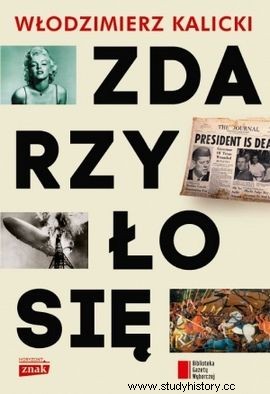
The article was also published as one of the chapters of the latest book by Włodzimierz Kalicki, entitled "It happened" (Znak Horyzont 2014).
Moment of truth
Shortly after nine in the morning, several Italian civilians and police officers arrive in the corridor. The policemen handcuff the hands of the convicts. They follow the confessor of the Great Fascist Council, Don Chiot, towards the exit gate.
It is cold, foggy, there is a thick layer of frost on the pavement. The streets of Verona are empty. The truck exits through the old city gate of Porta Catena and stops at the shooting range of Fort Procolo. Stalks of dead weeds stick out of the remnants of snow.
Marshal De Bono is the first to leave the parcel. He is only in a suit and a black hat, a little shivering from the cold. As the second, he jumps down on Ciano's grass. She looks very elegant in a long, light beige coat and a bright hat. After him, the other three men get off. Marinelli is unable to control herself, he is shaking with nerves, his legs refusing to obey him. The policemen are dragging his hands to the execution site.
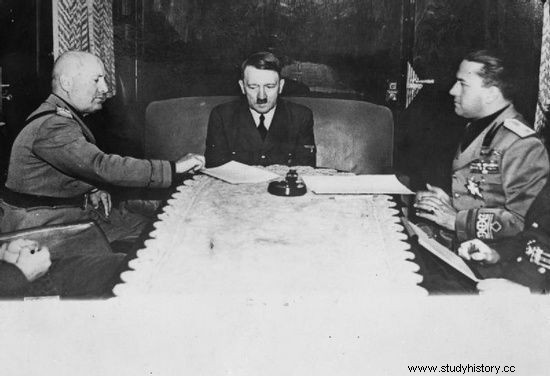
Initially, Ciano (right) opted for the Italian-German alliance. However, he changed his mind fairly quickly.
In the lowering of the ground, in front of a low earth rampart serving as a bullet trap, behind which stands the shooting range wall, old, wobbly chairs were placed - their backs towards the wall.
A dozen or so steps in front of the chairs there are thirty Italian policemen in short green winter jackets and black caps. They are commanded by the head of the fascist police in Verona, Nicola Furlotti. Shortly after World War I, he was one of the founders of the Black Shirts, Mussolini's paramilitary militias, but then, in the 1920s, he fell from grace and returned to the game only now, in the days when the fascist regime fell apart.
Right next to it are a dozen or so Italian officials and as many Germans - most of them are SS officers, there are also a few Nazi diplomats, a military photojournalist. The latter is nervously around the chairs, measures something with a light meter and is clearly dissatisfied . Low clouds and hazy air bode badly for the quality of the photos from the executions.
Execution in a negative light
Ciano is cool.
He exchanges a few words with Marshal De Bono who is saying the prayer. Both ask the leader of the execution, Furlotti, to let them come face to face with the firing squad. Furlotti refuses.
"By law, it's your chair, Marshal," Ciano says to De Bono, pointing to the first chair on the right.
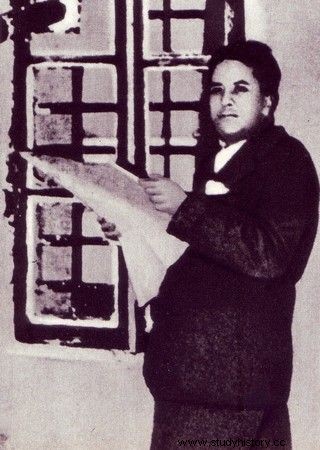
After the German paratroopers freed Mussolini, Ciano was arrested…
De Bono quite seriously replies that he does not believe that on the journey on which the convicts are about to be set off, prestigious priority would have any meaning. But he sits in the chair on the far right, with his back to the firing squad and the spectators.
Ciano sits down vigorously next to him. The old lopsided chair creaks, tilts, and Ciano lands in the frosted grass. He gets up by himself, sets the chair and sits down, carefully this time.
I want to meet the hangman's eyes
The policemen tie the hands of the convicts to the backs of the chairs. Ciano exclaims:
- Well, who would have guessed it!
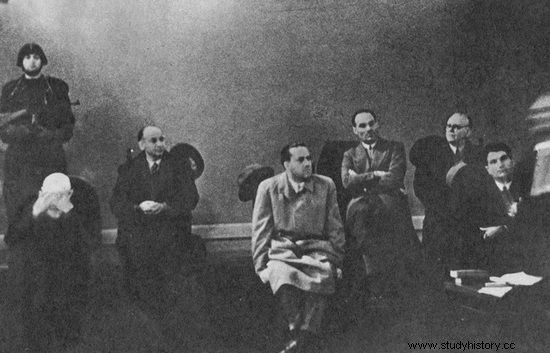
Then, along with others who contributed to the overthrow of the Duce, he was sentenced to death during the trial in Verona ...
He doesn't want to be blindfolded. Don Chiot in a long black cloak celebrates the immobilized condemned and whispers to them the words of absolution in articulo mortis . Ciano thanks him and asks the priest to take care of his three children.
When they tie Marinelli, Ciano shouts not to them, because it's a crime. Gets nervous, keeps turning back and swaying in the chair.
- Calm down man, you'll see it's nothing, one of the firing squad officers mockingly says.
On Furlotti's orders, policemen with small-caliber carcano rifles line up about 10 meters behind the squares of seated convicts, in two rows. Those in the front row kneel. The policemen are divided into five sixes - each one is to shoot one convict. It's 9.20. As Furlotti gives the command to unlock the gun, Gottardi jumps up from his chair and yells:
- Long live Duce! Long live Italy!
- Long live Italy! - Pareschi and De Bono also call.
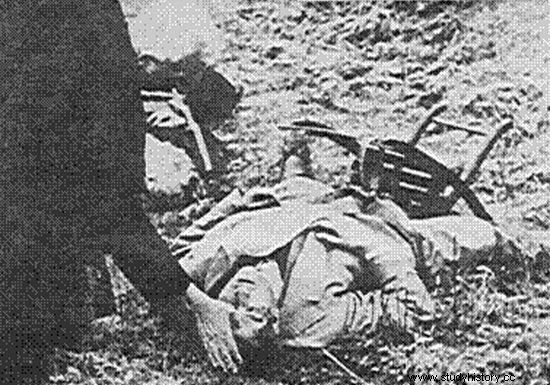
To finally hit the firing squad. In the photo, Monsignor Chiot is giving Galeazzo Ciano's last rites.
The command is "fire"
As soon as Ciano hears the command:"Fire!", He turns his face over his right shoulder towards the firing squad. Policemen miss the target, small-caliber bullets do not deal fatal wounds, even when hitting them. Four convicts with their chairs fall down onto the grass, Pareschi sits in the chair unmoved. Some policemen repeat their rifles and continue shooting chaotically at Pareschi and the lying ones.
Ciano gets five shots but is alive and conscious.
- Help! Help! - Croaks.
Furlotti draws a pistol from its holster. At his sign, several policemen also reach for handguns. Furlotti runs up to Ciano and shoots him very closely in the temple. Others kill the other four.
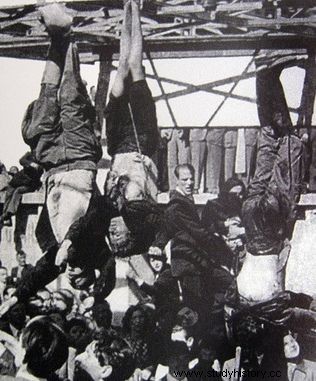
Benito Mussolini himself survived his son-in-law only a little over a year. Ending up hanged upside down at a Milanese gas station.
Two German officers come over and look closely at the dead Ciano's face - they want to be sure it's him.
Don Chiot covers his body with his coat. The prison doctor examines the bodies of the condemned and calls out that some of them are alive - you can feel the pulse. Furlotti goes back to the embankment and shoots everyone in the head again.
All this is viewed by SS officers with disgust. This is supposed to be an execution !? What a chaotic slaughterhouse! Typically Italian incompetence!
Source:
The article is a slightly shortened version of the chapter "Slaughterhouse in Verona" from the latest book by Włodzimierz Kalicki, entitled "It happened" (Znak 2014). The title, lead and subtitles come from the editors.
